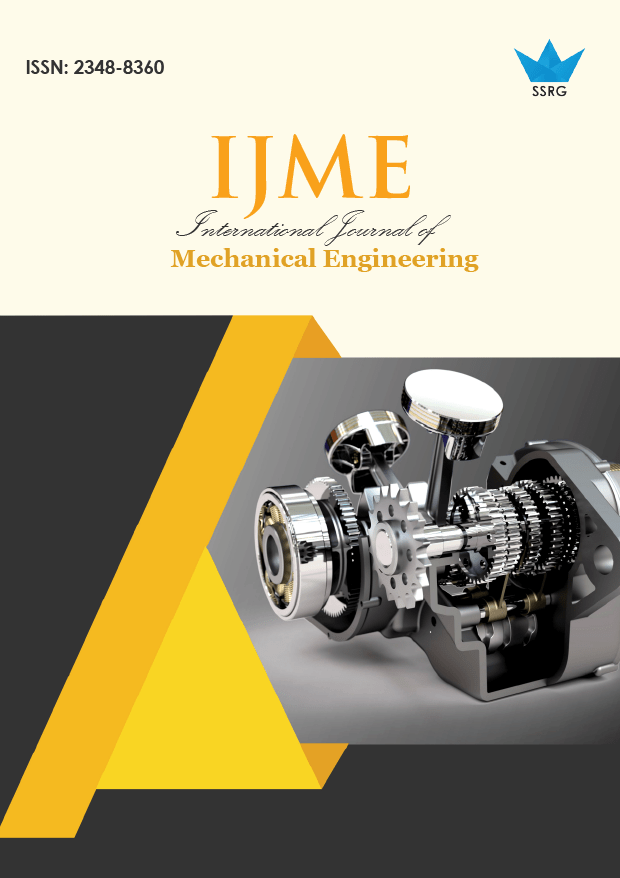A Dual-Method Framework Using SWARA–TOPSIS and SWARA-MACAB for Automotive Dealership Evaluation

| International Journal of Mechanical Engineering |
| © 2025 by SSRG - IJME Journal |
| Volume 12 Issue 10 |
| Year of Publication : 2025 |
| Authors : Devi Prasad Pilla, Ramji Koona, M. Pramila Devi |
How to Cite?
Devi Prasad Pilla, Ramji Koona, M. Pramila Devi, "A Dual-Method Framework Using SWARA–TOPSIS and SWARA-MACAB for Automotive Dealership Evaluation," SSRG International Journal of Mechanical Engineering, vol. 12, no. 10, pp. 138-148, 2025. Crossref, https://doi.org/10.14445/23488360/IJME-V12I10P112
Abstract:
With dealerships serving as essential middlemen between manufacturers and consumers, enabling both car sales and after-sales services, the automobile sector is essential to the expansion of the national economy. Dealership performance evaluation is a complex process that involves taking into account a number of qualitative and quantitative elements. 36 possible auto dealership choices are thoroughly evaluated in this study using hybrid Multi-Criteria Decision-Making (MCDM) techniques based on 16 criteria taken from the Balanced Scorecard framework. SWARA–MABAC and SWARA–TOPSIS are two new hybrid models that are presented. When the relative relevance of the criteria is assessed in both models using the Step-wise Weight Assessment Ratio Analysis (SWARA) approach, it is shown that the “LGP” criterion has the highest weight (25%), while the “FP4” criterion has the lowest weight (1.9%). The options are then ranked using the Technique for Order Preference by Similarity to Ideal Solution (TOPSIS) and the Multi-Attributive Border Approximation area Comparison (MABAC) techniques. Dealership DE3 continuously receives the highest ranking in both models, according to the comparison results, demonstrating the validity of the assessment procedure. In a competitive automobile market, this integrated approach provides decision-makers with a dependable framework for choosing a dealership, allowing for a balanced evaluation of strategic, financial, operational, and customer-oriented considerations.
Keywords:
Automotive Dealership Evaluation, Multi-Criteria Decision Making (MCDM), SWARA, TOPSIS, MABAC, Balanced Scorecard, Criteria Weighting, Hybrid Decision-Making Models, Dealership Performance Ranking, Alternative Evaluation.
References:
[1] Xin Jianghui, and Xie Naiming, “Grey Approach for Automobile Dealer Evaluation based on ‘Internet Plus Automotive Aftermarket,” Scientific Journal of Poznań, no. 70, pp. 69-87, 2016.
[CrossRef] [Google Scholar] [Publisher Link]
[2] Srinivasa Raju Komaragiri, and D. Nagesh Kumar, Multicriterion Analysis in Engineering and Management, PHL Learning Private Limited, pp. 1-288, 2014.
[Google Scholar] [Publisher Link]
[3] Raafat Ali Majeed, and Hatem Khaleefah Breesam, “Application of SWARA Technique to Find Criteria Weights for Selecting Landfill Site in Baghdad Governorate,” IOP Conference Series: Materials Science and Engineering: 1st International Conference on Engineering Science and Technology, Samawah, Iraq, vol. 1090, pp. 1-12, 2021.
[CrossRef] [Google Scholar] [Publisher Link]
[4] Emre Ipekci Cetin, and Ebru Tarcan Icigen, “Personnel Selection Based on Step-Wise Weight Assessment Ratio Analysis and Multi-Objective Optimization on the Basis of Ratio Analysis Methods,” World Academy of Science, Engineering and Technology: International Journal of Economics and Management Engineering, vol. 11, no. 11, pp. 2553-2557, 2017.
[Google Scholar]
[5] Sarfaraz Hashemkhani Zolfani, and Prasenjit Chatterjee, “Comparative Evaluation of Sustainable Design Based on Step-Wise Weight Assessment Ratio Analysis (SWARA) and Best Worst Method (BWM) Methods: A Perspective on Household Furnishing Materials,” Symmetry, vol. 11, no. 1, pp. 1-33, 2019.
[CrossRef] [Google Scholar] [Publisher Link]
[6] Dragisa Stanujkic, Darjan Karabasevic, and Edmundas Kazimieras Zavadskas, “A Framework for the Selection of a Packaging Design based on the SWARA Method,” Engineering Economics, vol. 26, no. 2, pp. 181-187, 2015.
[CrossRef] [Google Scholar] [Publisher Link]
[7] Ugur Bac, “An Integrated SWARA-WASPAS Group Decision Making Framework to Evaluate Smart Card Systems for Public Transportation,” Mathematics, vol. 8, no. 10, pp. 1-23, 2020.
[CrossRef] [Google Scholar] [Publisher Link]
[8] Maryam Alimardani et al., “A Novel Hybrid SWARA and VIKOR Methodology for Supplier Selection in an Agile Environment,” Technological and Economic Development of Economy, vol. 19, no. 3, pp. 533-548, 2013.
[CrossRef] [Google Scholar] [Publisher Link]
[9] Chaouki Ghenai, Mona Albawab, and Maamar Bettayeb, “Sustainability Indicators for Renewable Energy Systems using Multi-Criteria Decision-Making Model and Extended SWARA/ARAS Hybrid Method,” Renewable Energy, vol. 146, pp. 580-597, 2020.
[CrossRef] [Google Scholar] [Publisher Link]
[10] Dmitri Muravev, and Nemanja Mijic, “A Novel Integrated Provider Selection Multicriteria Model: The BWM-MABAC Model,” Decision Making: Applications in Management and Engineering, vol. 3, no. 1, pp. 60-78, 2020.
[CrossRef] [Google Scholar] [Publisher Link]
[11] Haresh Kumar Sharma et al., “Multi Criteria Evaluation Framework for Prioritizing Indian Railway Stations Using Modified Rough AHP-Mabac Method,” Transport and Telecommunication Journal, vol. 19, no. 2, pp. 113-127, 2018.
[CrossRef] [Google Scholar] [Publisher Link]
[12] Harshad Chandrakant Sonar, and Sourabh Devidas Kulkarni, “An Integrated AHP-MABAC Approach for Electric Vehicle Selection,” Research in Transportation Business & Management, vol. 41, 2021.
[CrossRef] [Google Scholar] [Publisher Link]
[13] Zdravko Nunić, “Evaluation and Selection of Manufacturer PVC Carpentry using FUCOM-MABAC Model,” Operational Research in Engineering Sciences: Theory and Applications, vol. 1, no. 1, pp. 13-28, 2018.
[CrossRef] [Google Scholar] [Publisher Link]
[14] Slavko Vesković et al., “Evaluation of the Railway Management Model by using a New Integrated Model DELPHI-SWARA-MABAC, Decision Making: Applications in Management and Engineering, vol. 1, no. 2, pp. 34-50, 2018.
[CrossRef] [Google Scholar] [Publisher Link]
[15] Santonab Chakraborty et al., “An Integrated Performance Evaluation Approach for the Indian Smart Cities,” Opsearch, vol. 58, pp. 906-941, 2021.
[CrossRef] [Google Scholar] [Publisher Link]
[16] Ganda Boonsothonsatit et al., “Development of a Hybrid AHP-TOPSIS Decision-Making Framework for Technology Selection in Hospital Medication Dispensing Processes,” IEEE Access, vol. 12, pp. 2500-2512, 2024.
[CrossRef] [Google Scholar] [Publisher Link]
[17] Priyank Trivedi et al., “A Hybrid Best-Worst Method (BWM)—Technique for Order of Preference by Similarity to Ideal Solution (TOPSIS) Approach for Prioritizing Road Safety Improvements,” IEEE Access, vol. 12, pp. 30054-30065, 2024.
[CrossRef] [Google Scholar] [Publisher Link]
[18] Ahmed E. Youssef, “An Integrated MCDM Approach for Cloud Service Selection Based on TOPSIS and BWM,” IEEE Access, vol. 8, pp. 71851-71865, 2020.
[CrossRef] [Google Scholar] [Publisher Link]
[19] Mazin Abed Mohammed et al., “Benchmarking Methodology for Selection of Optimal COVID-19 Diagnostic Model Based on Entropy and TOPSIS Methods,” IEEE Access, vol. 8, pp. 99115-99131, 2020.
[CrossRef] [Google Scholar] [Publisher Link]
[20] Lanjing Wang et al., “ISA Evaluation Framework for Security of Internet of Health Things System Using AHP-TOPSIS Methods,” IEEE Access, vol. 8, pp. 152316-152332, 2020.
[CrossRef] [Google Scholar] [Publisher Link]
[21] Pankaj Prasad Dwivedi, and Dilip Kumar Sharma, “Evaluation and Ranking of Battery Electric Vehicles by Shannon’s Entropy and TOPSIS Methods,” Mathematics and Computers in Simulation, vol. 212, pp. 457-474, 2023.
[CrossRef] [Google Scholar] [Publisher Link]
[22] M. Mujiya Ulkhaq et al., “Combining the AHP and TOPSIS to Evaluate Car Selection,” Proceedings of the 2nd International Conference on High Performance Compilation, Computing and Communications, Hong Kong Hong Kong, pp. 112-117, 2018.
[CrossRef] [Google Scholar] [Publisher Link]

 10.14445/23488360/IJME-V12I10P112
10.14445/23488360/IJME-V12I10P112